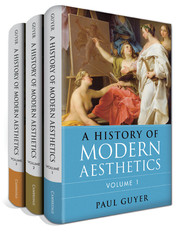Book contents
- Volume 1 The Eighteenth Century
- Volume 2 The Nineteenth Century
- Frontmatter
- Contents
- Acknowledgments
- Introduction
- Part One German Aesthetics in the First Half of the Nineteenth Century
- Part Two (Mostly) British Aesthetics in the Second Half of the Nineteenth Century
- Part Three German Aesthetics in the Second Half of the Nineteenth Century
- 8 In the Shadow of Schopenhauer
- 9 Neo-Kantian Aesthetics
- 10 Psychological Aesthetics
- Bibliography
- Index
- Volume 3 The Twentieth Century
- References
9 - Neo-Kantian Aesthetics
from Part Three - German Aesthetics in the Second Half of the Nineteenth Century
Published online by Cambridge University Press: 05 June 2015
- Volume 1 The Eighteenth Century
- Volume 2 The Nineteenth Century
- Frontmatter
- Contents
- Acknowledgments
- Introduction
- Part One German Aesthetics in the First Half of the Nineteenth Century
- Part Two (Mostly) British Aesthetics in the Second Half of the Nineteenth Century
- Part Three German Aesthetics in the Second Half of the Nineteenth Century
- 8 In the Shadow of Schopenhauer
- 9 Neo-Kantian Aesthetics
- 10 Psychological Aesthetics
- Bibliography
- Index
- Volume 3 The Twentieth Century
- References
Summary
Neo-Kantianism “officially” began with the command, or plea, “Back to Kant!” issued by the twenty-five-year-old Otto Liebmann, subsequently professor of philosophy at Strassburg and Jena, in 1865. But what this call meant is far from simple. The import of the plea must be understood in its historical context, where the authority of Kant was to be used to criticize both the speculative, “absolute” idealism of Fichte, Schelling, and Hegel that had immediately followed Kant as well as the attempt to ground philosophy on empirical psychology by Gustav Theodor Fechner, Hermann von Helmholtz, and others that had been a previous response to post-Kantian idealism. However, while it might have been expected that a Neo-Kantian movement in aesthetics would develop Kant’s synthesis of the aesthetics of truth and the aesthetics of play and perhaps find a way to add recognition of the emotional impact of art and nature on to Kant’s own theory of aesthetic ideas, that is not what initially happened in Neo-Kantianism. Instead, certainly the first great Neo-Kantian, Hermann Cohen, the leader of the Marburg school, retained the outlines of Kant’s analysis of judgments of taste but dropped his explanation of the pleasure that underlies such judgments as the product of the free play of imagination and understanding; he then recognized the importance of emotions in aesthetic experience, but framed that recognition within an essentially cognitivist approach to aesthetic experience, finding the essence of aesthetic experience to be cognition of the nature of human feelings through art. He thus rejected the speculative metaphysics of Hegelian aesthetics, but retained a cognitivist approach by making human emotions themselves the object of aesthetic cognition. Jonas Cohn, a figure not from the first but from the second generation of the other main school of Neo-Kantianism, the Heidelberg or Southwest school founded by Wilhelm Windelband, made the communication of emotion central to his in this regard deeply un-Kantian aesthetic theory, and in this way came closer to recognizing the experience rather than merely the cognition of emotions as an essential part of aesthetic experience.
- Type
- Chapter
- Information
- A History of Modern Aesthetics , pp. 325 - 377Publisher: Cambridge University PressPrint publication year: 2014



